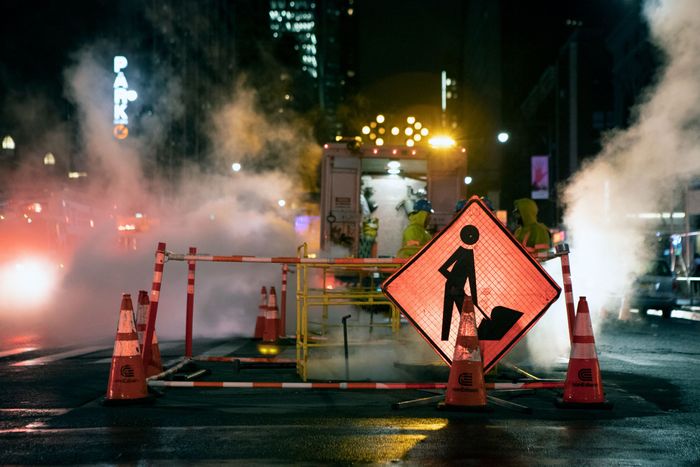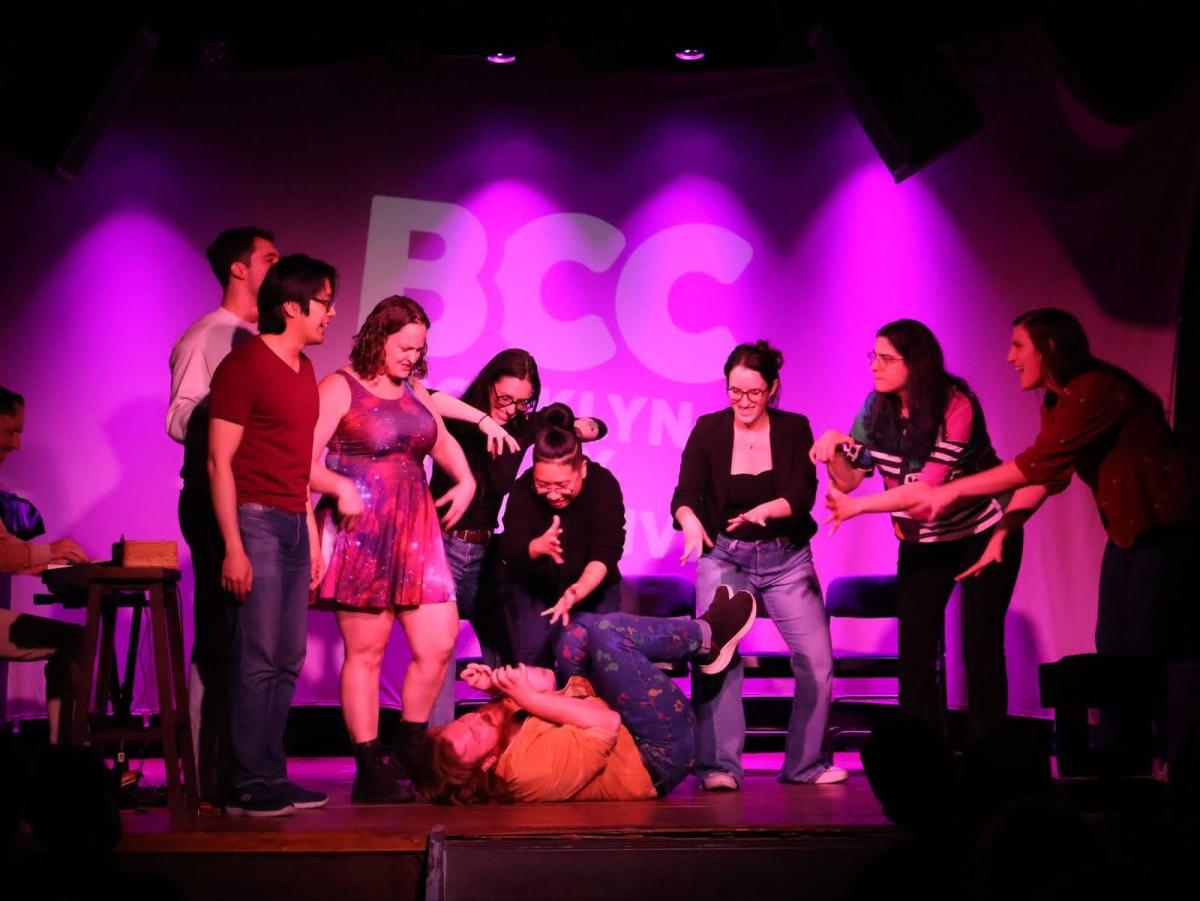By and , THE CITY

This story was originally published on Feb. 24, 2020 by THE CITY.
Osman Bah was driving his taxi through Midtown when an underground explosion shot four heavy manhole covers into the air. The blast near Lexington Avenue and 44th Street sent one of the metal covers crashing through Bah’s windshield. He suffered debilitating, permanent injuries that crippled one side of his body. “I’m not the person who I was anymore,” he said, looking back at his life before Nov. 17, 2014. The blast that injured Bah was among nearly 4,000 FDNY dispatches for manhole explosions logged between 2009 and 2018, Fire Department records obtained through a Freedom of Information Law request show. Those were among more than 45,000 emergency manhole incidents, including smoke and fire episodes, logged during the span, according to the FDNY. At least 57 people were injured during that period, along with nine more injuries in 2019, according to an analysis of lawsuits and local news reports. The explosions also caused significant property damage, building evacuations, power outages and traffic disruptions. Exploding manholes are primarily a winter phenomenon. On average, firefighters responded to around three manhole explosions per day during the months of January and February in the last decade. The most common cause is out of Chemistry 101: a combination of aging electrical infrastructure — especially old wiring — and rain or snow melt mixed with corrosive salt spread to reduce icing on roads. The data does not specify which utility was responsible for each incident, but with 246,000 manholes and service boxes in its underground system, Con Edison is the largest electric provider in the city. The utility has for decades blamed manhole issues on road salt that erodes underground cables, and contends weather has a “direct impact” on its electrical system. Meanwhile, some experts and former utility workers say that lack of upkeep is at the root of the problem. Con Edison counters that it invests heavily on maintenance annually. “The safety of our employees and the public is our top priority,” said Robert McGee, a spokesperson for Con Edison. “While there are some risks in the delivery of electricity, we are constantly developing and implementing innovative technology to try to minimize electrical fires and explosions.” City legislators have considered several times tightening oversight of manhole incidents but failed to pass various measures. At the state level, the Public Service Commission –– the board that oversees public utilities –– has the authority to pressure Con Edison to reduce incidents, but has never fined any utility company for manhole explosions. Critics say the PSC has since the 1990s leaned on “a more lightened regulatory approach” that does little to ensure “preventive maintenance.” The manhole cover that slammed into Bah’s taxi knocked him out. “I went unconscious and was taken to the hospital,” he told THE CITY. Five years later, Bah is still recovering from bodily injuries, struggles with memory loss and rarely leaves his Queens home except to see doctors. He no longer works. “Basically, all of my left side as we are speaking right now is numb,” he said. In March 2015, he sued Con Edison and the city for “severe, serious, and permanent personal injuries.” The complaint, filed in Manhattan Supreme Court, alleges the utility was negligent “in allowing a dangerous and explosive condition to exist within a manhole.” The case is ongoing. Con Ed, which employs a small army of lawyers, regularly fights off injury lawsuits related to manhole explosions. The cases often take years to resolve. Take the case of Jeffrey Lide.
Lide was parked on Nostrand Avenue in Brooklyn on Jan. 28, 2014, when he heard a strange noise coming from below. Moments later, he heard what sounded like “a big bomb” and was lifted into the air. The manhole under Lide’s car had exploded, according to a police report. “I didn’t know what the hell happened,” he told THE CITY. When his car dropped back down, Lide stumbled out of the driver’s seat and sprinted across the street. That’s when his 2009 Infiniti sedan exploded. “I saw a ball of fire go through the car,” he said. “My gas tank was on top of the manhole cover.” Lide was hospitalized with extensive injuries to his spine and shoulder, according to a lawsuit filed against Con Edison in Brooklyn. It took him six months to recover from surgery, and he says he may soon need another operation. In total, he racked up $75,000 in medical bills, according to his complaint. Lide declined to comment on the lawsuit, which he said was ongoing. Manhole fires and explosions date to the early days of electrification in New York City. A 1915 New York Times story, for instance, chronicles two manhole blazes that stranded subway riders at 53rd Street and Broadway. When manholes explode, they send cast iron covers that weigh between 70 and 300 pounds flying through the air. The ear-splitting blasts can shatter nearby windows, set off car alarms and often send flames and debris shooting up from the street.
“The rocks and pebbles are blown out like bullets,” said Frank Montagna, a retired FDNY battalion chief. “You can get burned.” Other hazards are invisible.
“Anytime there’s a manhole fire, you get very high concentrations of carbon monoxide and other toxic gases,” said Montagna, who spent eight of his 43 years with the department teaching at the FDNY Fire Academy. “I’ve seen where, from a manhole fire at one corner, you had carbon monoxide in buildings several blocks away. And carbon monoxide is deadly, and it will kill.” He recalled an incident in 2006, when a manhole blast in The Bronx flipped a Cadillac Escalade onto a firefighter who had been putting out another blaze nearby. Marc Kroenung, who was wearing a helmet, survived by crashing through the vehicle’s window. Kroenung sued Con Edison. The case was settled before trial in 2010. Last April, several firefighters were injured in a manhole blast that forced three building evacuations in Midtown. One of the firefighters is suing Con Edison for personal injuries, according to court records. The most recent fatal manhole incident in New York City happened on Oct. 8, 2008. George Dillman, a cable splicer for Con Edison, was doing maintenance work in a Brooklyn manhole when an electrical issue lit up the underground vault in flames. It took more than two hours to retrieve Dillman’s body from the manhole, which burned as crews struggled to shut off the power, according to a Con Edison report. Four years before Dillman’s death, two Con Edison workers were killed in a manhole explosion that injured several people in Yonkers. A federal investigation later found that Con Edison violated safety measures by failing to turn off leaky electrical wires in the manhole before crews worked on them. The Occupational Safety and Health Administration fined the utility $35,000. The most recent effort to tighten city regulations for manhole incidents came in 2018. Councilmember Donovan Richards, who is running for Queens borough president, first introduced a bill in 2015 requiring the Fire Department to submit annual reports to the City Council on manhole incidents. The bill, which did not make it past committee, was reintroduced in 2018. “If the utilities are inspecting and upgrading their infrastructure, then the streets of New York would be safer,” Richards told THE CITY recently. He said that city officials should not rely exclusively on reports produced by the utilities. “We’re not always confident that we are getting the most detailed data,” he said. State law requires public utilities to inspect their electric facilities for defects on a five-year cycle. That rule was established by the Public Service Commission in 2005, following the much publicized death of 30-year-old Jodie Lane, who was killed a year earlier when she stepped on an electrified service box in the East Village. In 2006, then-Councilmember John Liu introduced the “Street Utilities Safety Act, which proposed fining utilities up to $5,000 for every manhole deemed hazardous after inspections by the city. But the bill never passed despite support from high-profile City Council members like Bill de Blasio, Gale Brewer and Letitia James — now mayor, Manhattan borough president and state attorney general, respectively. Now a state senator, Liu still believes that financial penalties against Con Edison are the best way to address manhole issues. “Private for-profit companies understand one language only and that’s the language for which there is only one character: the dollar sign,” said Liu, a longtime critic of Con Edison. But state regulators disagree. The Public Service Commission has the power to fine Con Edison for individual manhole incidents — but has never done so. “Rather than issue financial penalties for singular manhole events, the PSC has required Con Edison to make substantial investments to improve the overall safety and reliability of the underground system,” said James Denn, a spokesperson for the commission. “Penalties for singular manhole events can be adjudicated in civil court,” he added. The commission also approved a pilot program in 2015 that requires Con Edison to inspect all underground distribution facilities over the course of eight years. The PSC contends that its approach has helped.
Con Ed data shows that the total number of manhole events has decreased since 2015, along with fewer explosions and fires. A longer look at the data, however, is less conclusive. Despite fluctuations from year to year, manhole fires, explosions and smoke incidents have remained fairly consistent since 2005, when the PSC adopted new safety laws after the death of Jodie Lane. For years, critics have accused the PSC’s approach of being too loose, allowing Con Edison to cut spending on maintenance. After a major blackout left more than 100,000 Queens residents without power during the summer of 2006, the New York State Assembly issued a damning report that rebuked the PSC for lax oversight. “The task force is concerned that performance-based regulation as conducted by the PSC might be contributing to a reduction in the overall reliability of Con Edison’s distribution system,” the report said. Since the 1990s, the commission has relied on regulations it believes encourage good practices, and it grades Con Edison on safety and reliability to decide whether the company can increase rates. But manhole incidents do not count against Con Edison’s safety grade, according to the PSC. Gerald Norlander, the former executive director of the nonprofit Public Utility Law Project of New York, said that until the PSC starts counting manhole explosions toward a utility’s performance rating, there will be no incentive to make improvements. “You’re gonna get what you’re measuring and maybe not much more,” said Norlander. “So you better make sure you’re measuring the right stuff. And I think that things blowing up is something to count.” Below New York City’s asphalt, Con Edison operates a massive grid of around 95,000 miles of cables. In this electrical maze, low-voltage wires travel in narrow passageways that eventually reach manholes. From there, the utility runs service cables to individual buildings and homes. Inside manholes, electrical cables are supposed to be racked or “shelved” along the walls, but former Con Edison workers say that’s not always the case. Instead, cables are sometimes stuffed into the manholes, making it easier for them to get damaged, the former workers say. Mark Williams, a former technician who left the Con Edison in 2001, said the utility puts “10 pounds of crap in a 5-pound bag.” Manholes are sometimes so packed that wires spew out above ground “like a bunch of spaghetti,” Williams told THE CITY. Following Lane’s death in 2004, Williams criticized Con Edison for lack of maintenance at a City Council hearing. “Con Edison does not invest resources in its overhead and underground infrastructure,” Williams said at the time, while representing the Utility Workers Union of America in his testimony. “It tells union workers to cut corners and rush through jobs.” For at least four decades, Con Ed and city officials have blamed manhole incidents on bad weather and road salt that corrodes underground wires, leading to a combustible buildup of gas that can explode at the presence of a spark. “Road salt is a major contributor to underground electrical incidents, and we have worked on technology to prevent manhole covers from becoming dislodged or causing a hazard to the public,” said Con Edison’s McGee. “We remain committed to providing the most reliable and safest electrical delivery system possible,” he added. To improve manhole safety, the utility has installed 21,500 miles of corrosion-resistant cables, along with gas monitoring systems and vented covers that latch to avoid being dislodged, McGee said. In total, Con Edison invests more than $1 billion to upgrade its underground electrical system every year, he said. The total number of manhole explosions in Con Edison’s system is “not even close” to the figures reported in FDNY dispatch data, he said. When asked to clarify the disparity, Frank Dwyer, a spokesperson for the FDNY, told THE CITY to ask Con Edison. Con Edison’s spokesperson responded by saying ask the FDNY. Neither ultimately offered an explanation.
The city’s Department of Sanitation, which is in charge of de-icing roads during snowstorms, says it does not do any research on the link between manhole fires and salt. “Providing safe, passable streets and roadways for New Yorkers is a top priority for our department,” said Dina Montes, a Sanitation spokesperson. In response to a question about possible city initiatives to reduce manhole explosions, the mayor’s office told THE CITY that “public safety involves balancing a range of needs.” “Salt is our best protection against slick roads, which can pose a danger to New Yorkers in the winter months,” said Laura Feyer, a spokesperson for Mayor Bill de Blasio. “Manhole incidents are not unique to New York City, and can occur at any time of year due to weather conditions, including rain, whether salt is on the road or not.” Some say that manhole incidents could be avoided if Con Edison upgraded its safety equipment underground. “It’s absolutely preventable,” said Glen Bertini, an explosion mitigation expert and senior member of the American Institute of Chemical Engineers. “Salt water is a contributing factor, but it’s not a root cause.” Blaming the issue on winter salting allows Con Edison to throw the responsibility back to the city, Bertini said. “They’re always looking for a scapegoat,” he said. “The fundamental cause of that fire is the aging cables somewhere.” Bertini is the author of several research papers on manhole explosions. His company, Novinium, designs smart covers, monitoring devices and fans that he says help prevent the blasts. “Fans are cheap and they are very reliable,” he said. “Just a general breeze coming up continuously, and it can never explode.” Meanwhile, Osman Bah now sees his life into two phases — before the explosion and after. “I had good health, never got sick,” he said.
Other than “a loud sound with a lot of smoke,” Bah remembers very little about the blast. “I can’t recall certain things anymore, and I just don’t want to deal with it,” he said, adding that he wants “to try to get my life back. “Which I don’t think I will.”
Cold Combustion

Multiple Lawsuits
An Old Problem

Calls for More Data
Encouragement Over Penalties
Underground Spaghetti

Salt on Roads

A Life Forever Changed
This story was originally published by THE CITY, an independent, nonprofit news organization dedicated to hard-hitting reporting that serves the people of New York.






































